Meet the American Monks Who Might Re-Evangelize Ireland
A U.S. Benedictine community has planted roots in the Emerald Isle, becoming the first new monastery in the Diocese of Meath since the Reformation.

DUBLIN — Local Catholics have too often been used to nothing but bad news about religious life in Ireland: Whether it’s the punishing revelations about past abuses in institutions run by religious orders or the dearth of vocations, the picture has often seemed bleak.
But news that a new monastery has been established in the Diocese of Meath — the first in that diocese since the Reformation — is raising hopes for a new springtime in religious life in the island once dubbed the “Land of Saints and Scholars.”
Nestled in the heart of the Boyne Valley in Stamullen, County Meath, Silverstream Priory has been open for five years. At a time when many religious communities are consolidating and closing down houses, the Benedictines at Silverstream have an ambitious plan of work to build their monastic community as a powerhouse of prayer and hospitality. “Hardly a day passes when I do not receive a vocational enquiry,” said its prior, Dom Mark Kirby.
That plan took a step forward on Feb. 25, when Bishop Michael Smith of Meath presided at the canonical establishment of a new monastery at Silverstream. The monks follow the Rule of St. Benedict and came to Ireland from Tulsa, Oklahoma, in 2012. The monks have made their home in Silverstream House, built in 1843, and their community is contemplative in nature, with a particular focus on the Divine Office and Eucharistic adoration.
Bishop Smith signed a decree Feb. 25, “erecting the Benedictine Monks of Perpetual Adoration of the Most Holy Sacrament of the Altar as a monastic Institute of Consecrated Life of diocesan right in the Diocese of Meath.” The decree is believed to mark the first formal establishment of a monastic community in the Diocese of Meath since the suppression of the monasteries by Henry VIII in 1536.
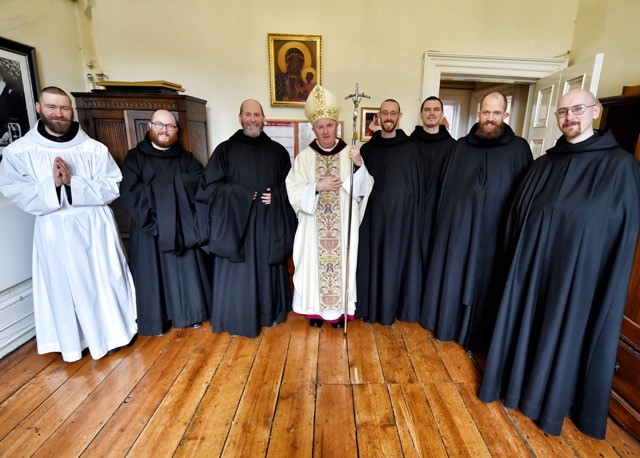
During the Mass, Bishop Smith said, “The history of religious life has seen many developments over the centuries, and I am delighted to recognize the unique presence of this new monastery in the Diocese of Meath. Through their prayer, study and hospitality, the monks are ‘speaking to the heart,’ and their quiet witness is a reminder that the Lord continues to provide the Church with new gifts and grace.”
The community’s constitution and canonical norms were approved by the Holy See earlier this month.
How It Began
Conventual Prior of the Institute Dom Kirby, 64, was born and raised in the United States, but he feels that the gentle hand of God has led him to Ireland. The story took shape in 2007, during a lengthy layover in Dublin airport en route to Rome. Dom Mark wanted to celebrate Mass, and so went to the airport church. While there, a prayer came to him: “Lord, let me do something for the Church in Ireland.” At a conference in Rome in 2011, he met some people from Ireland, and he shared with them the fact that Eucharistic adoration and a special care for priests is at the heart of the charism of his community, which then was based in Oklahoma. The Irish people he met shared their hope that such a community could benefit the Church in Ireland.
“The invitation to consider Ireland touched me deeply, because, for several years, I had felt a growing desire to respond to the needs of the Church in Ireland with a humble love.”
In a certain sense, establishing a Benedictine community in Meath was a sort of coming home. “The Diocese of Meath has a rich and ancient monastic heritage going all the way back to St. Finnian (470-549) and his disciples,” according to Dom Mark.
“Dom Benedict [the other monk with whom Dom Mark founded the community at Silverstream] and I were conscious that, in God’s providence, we were called to rekindle the torch that blazed from the Benedictine abbey of Fore in County Westmeath until its suppression under Henry VIII in 1536.”
God’s Providence
And God’s providence has certainly shone on the community. “Since our arrival at Silverstream in 2012, our Benedictine community has grown steadily, from two to eight members. Two more men, both in their 20s, will enter the novitiate later this spring.” Currently, the community is made up of four professed and four novices. Three of the community are priests.
The community is also international in character, representing Ireland, the U.S., Denmark and Australia. Interestingly, two of the men are converts to the Catholic faith. Bucking the trend in religious life, all but one of the monks is under 36 years of age, with several men in their 20s. “Our goal is to implant traditional Benedictine life at Silverstream,” according to Dom Mark. “This means a close adhesion to the letter and spirit of the Rule [of St. Benedict] and a commitment to the traditional forms of the sacred liturgy in Latin and Gregorian chant.”
Mass at the priory is celebrated in the extraordinary form, and the community has gathered a healthy congregation, particularly on Sundays.
“We have people coming from all over Ireland,” Dom Benedict said.
“Some people travel from Dublin, from Belfast and farther afield. We have young families and many people from different ethnic backgrounds.”
The traditional Latin Mass is celebrated every day in the provisional oratory. The monks also celebrate the full Divine Office, reciting the entire 150 Psalms over the course of a week.
The community is convinced that people can be attracted to an authentic encounter with Christ through beauty. “When people approach the Church,” Dom Mark insists, “we must offer them beauty. We must enchant people and attract them, by pointing them towards something that is beautiful.”
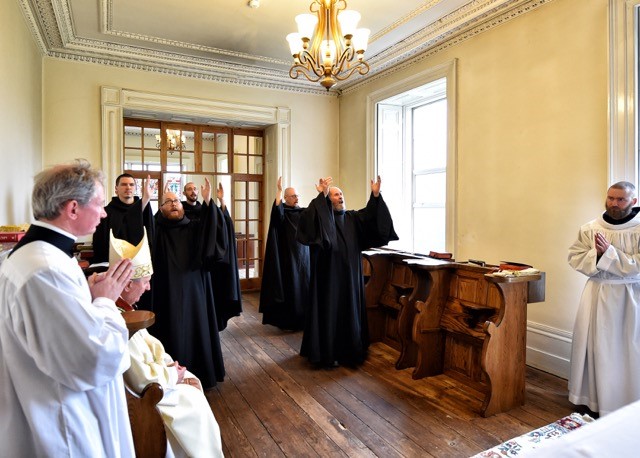
But, like many religious foundations, there have been times when it has been tough going. Dom Mark admits that “the first five years have been difficult and, at certain hours, hardly looked promising, as we had to struggle with a poorly heated house through cold, damp winters and with woefully outdated and inadequate electrical and plumbing systems.
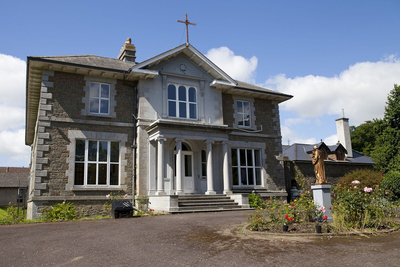
But the monks are not resting on their laurels, and there are big plans afoot. Dom Mark says that the “next project — and it is urgent — is the conversion of a dilapidated cattle shed into a chapel equipped for a community of between 25 and 30 monks.”
The current chapel is a makeshift arrangement. There are only 10 choir stalls, and, very soon, the new men will be sitting on the windowsills.
Monastic Life’s Vital Role
In an age where people often value apostolic work over contemplative work, Dom Mark is passionate about the vital role monastic life plays in the life of the Church. “People often ask me, ‘What good are monks, silent and enclosed behind walls, when so much cries out to be done in our troubled world?’” he said.
“We monks, by remaining faithful to our daily round of liturgical prayer — seven times a day and once in the night — provide the Church, the Body of Christ, with the regular heartbeat of the Divine Office.”
“The Church, if she is to be a healthy organism, needs a regular heartbeat. Without the prayer of monks, the Church would suffer from a kind of spiritual cardiac arrhythmia and, over time, slip into a critical lethargy,” the prior insists.
The monks at Silverstream very much see their monastic way of life as being at the heart of the Church’s mission.
According to Dom Mark, “The Church has bishops and priests to stand at her altars and to shepherd the flock; she has a voice in her preachers and teachers; she has hands and feet in her caregivers and missionaries. In us monks, the Church has her heart.”
Added the Benedictine prior, “So long as there a monks in their choir stalls, manfully singing the praises of God by day and by night, and monks in adoration before the altar where the living Christ is truly present in the sacrament of his love, the Church will be forever young, forever alive and equipped to continue her mission into generations to come.”
Michael Kelly is the editor of The Irish Catholic. He writes from Dublin.
Editor's Note: Photos below were added May 26, 2017.
This story appears in the May 28, 2017, print issue of the Register.
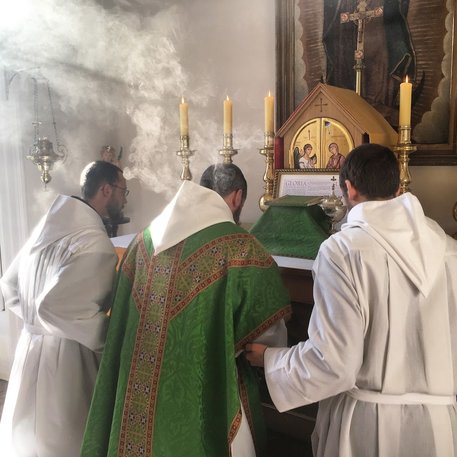
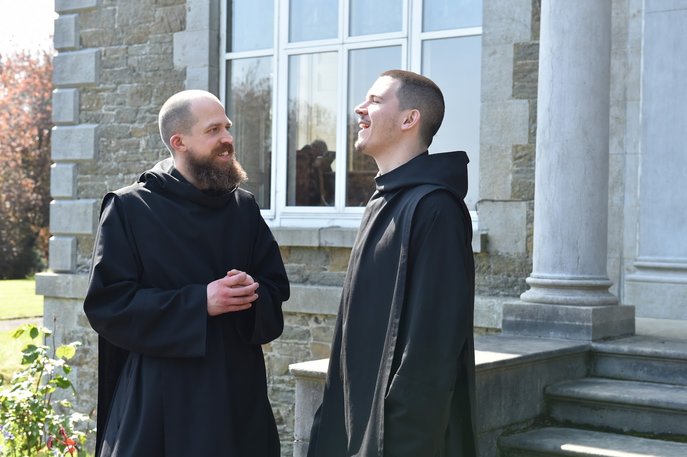
- Keywords:
- benedictines
- ireland
- michael kelly
- monks
- religious life
















